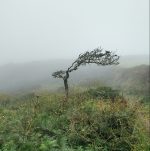 At the end of 2023, following my visit to IBM [see ‘Chirping while calculating probabilities‘ on November 22nd, 2023], I spent a significant amount of time trying to understand quantum computing and exploring its potential applications in my research. It was really challenging because, as one article I read stated, quantum-mechanical phenomena appear to be weird and the mathematical tools used to model them are complex and abstract. Just to make it harder you have to learn a new language or at least new terminology and mathematical notation. I have always found that my unconscious mind is capable of solving mathematical problems given sufficient time and sleep. However, the mathematics of quantum computing took many nights of unconscious thought to assemble into some sort of understanding and left me with mild headaches. Around the same time I was reading one of Cormac McCarthy’s new novels, Stella Maris, which consists entirely of a psychologist interviewing a mathematician who is a patient in a hospital. They discuss that mathematical work is performed mostly in the unconscious mind and we have no notion as to how the mind goes about it. They find it hard to avoid the conclusion that the unconscious mind does not use numbers. I suspect that it does not use mathematical notation either; perhaps it is more a form of synaesthesia using three-dimensional shapes [see ‘Engineering synaesthesia‘ on September 21st, 2016]. A couple of pages before discussing the unconscious mind’s mathematical work, one of the protagonists comments that ‘If we were constructed with a continual awareness of how we worked we wouldn’t work’. So, perhaps I should not probe too deeply into how I have acquired a rudimentary understanding of quantum computing.
At the end of 2023, following my visit to IBM [see ‘Chirping while calculating probabilities‘ on November 22nd, 2023], I spent a significant amount of time trying to understand quantum computing and exploring its potential applications in my research. It was really challenging because, as one article I read stated, quantum-mechanical phenomena appear to be weird and the mathematical tools used to model them are complex and abstract. Just to make it harder you have to learn a new language or at least new terminology and mathematical notation. I have always found that my unconscious mind is capable of solving mathematical problems given sufficient time and sleep. However, the mathematics of quantum computing took many nights of unconscious thought to assemble into some sort of understanding and left me with mild headaches. Around the same time I was reading one of Cormac McCarthy’s new novels, Stella Maris, which consists entirely of a psychologist interviewing a mathematician who is a patient in a hospital. They discuss that mathematical work is performed mostly in the unconscious mind and we have no notion as to how the mind goes about it. They find it hard to avoid the conclusion that the unconscious mind does not use numbers. I suspect that it does not use mathematical notation either; perhaps it is more a form of synaesthesia using three-dimensional shapes [see ‘Engineering synaesthesia‘ on September 21st, 2016]. A couple of pages before discussing the unconscious mind’s mathematical work, one of the protagonists comments that ‘If we were constructed with a continual awareness of how we worked we wouldn’t work’. So, perhaps I should not probe too deeply into how I have acquired a rudimentary understanding of quantum computing.
BTW in case you missed my last post at the start of January [‘600th post and time for a change‘ on January 3rd 2024] and have been wondering what has happened to my weekly post – I have decided to switch to posting monthly on the first Wednesday of each month.
Source:
Cormac McCarthy, Stella Maris, Picador, 2022.


